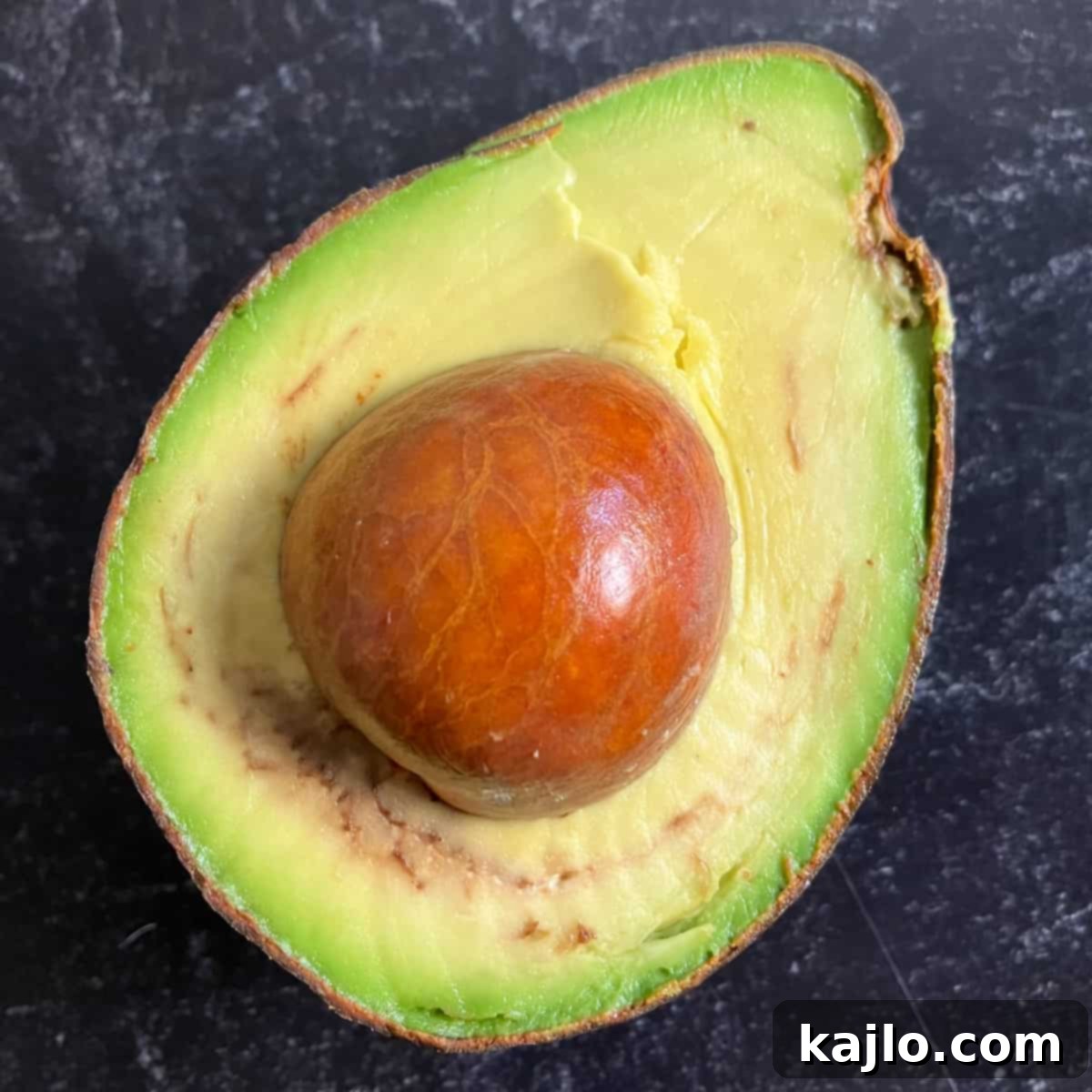Have you ever cut open a beautiful green avocado, only to find it mottled with unsightly brown or black spots? It’s a common dilemma that leaves many wondering: Can you eat avocado with brown spots? The good news is, most of the time, those dark patches are perfectly safe. However, there are instances when an avocado has truly gone bad, and consuming it could lead to an unpleasant experience. This comprehensive guide will delve into the various reasons behind avocado black spots and avocado brown spots, teaching you precisely how to tell if an avocado is bad and which types of discoloration are safe to eat. We’ll also cover crucial tips for preventing browning, proper storage, and even how to make the most of an avocado that’s past its prime aesthetic. Don’t let a “bad” avocado ruin your meal—get the full scoop on avocado dark spots and ensure your culinary creations are always top-notch.
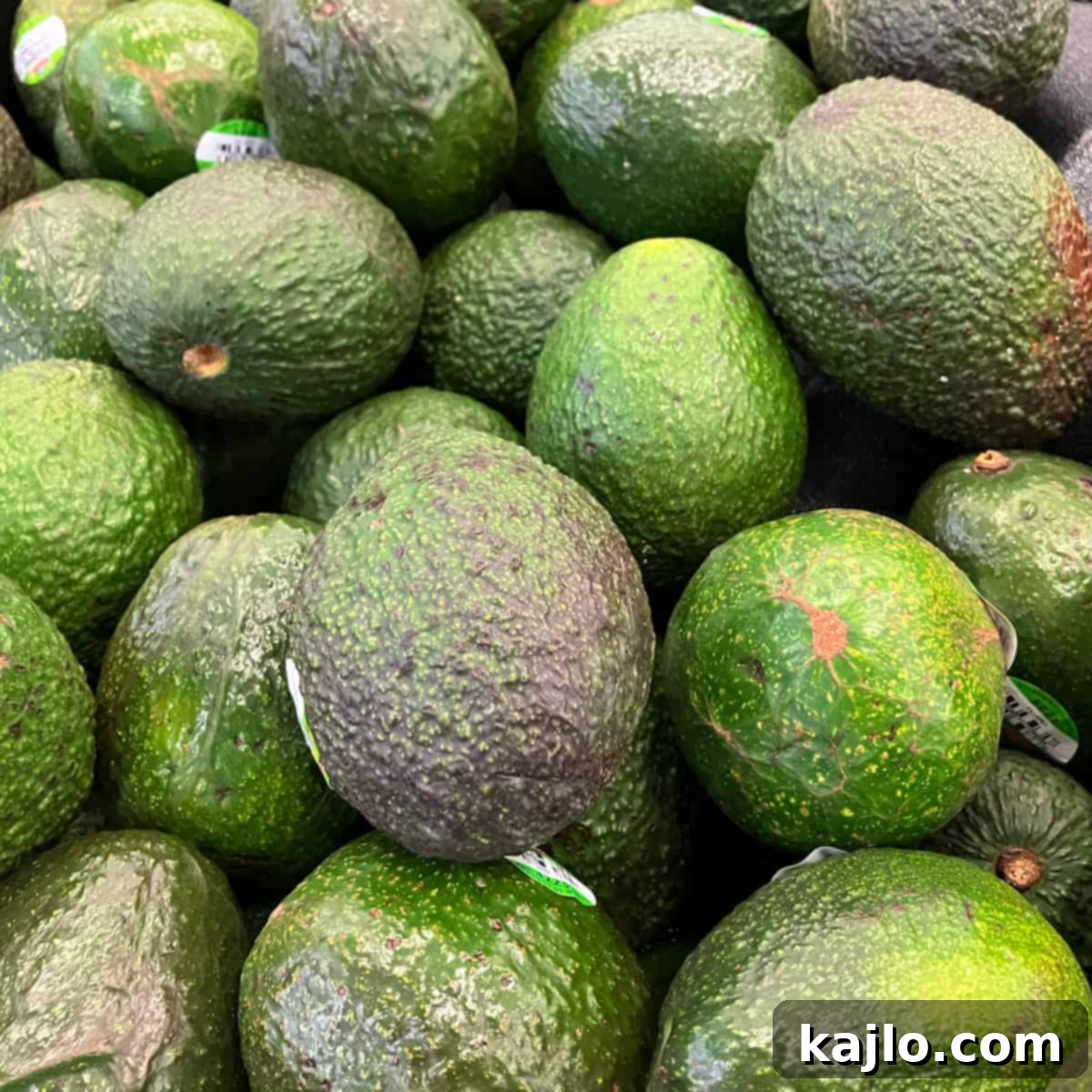
Discovering your avocado brown inside can be a bit disheartening, especially when you’re anticipating that perfect creamy texture for your toast or guacamole. While it’s natural to question whether it’s safe to consume, in many cases, brown spots on avocado are merely cosmetic and nothing serious. These discolorations often indicate an overripe avocado or one that experienced some rough handling, such as bruising during its journey from the farm to your kitchen.
However, the spectrum of avocado discoloration isn’t limited to harmless browning. Sometimes, you might encounter more pronounced signs, such as stark black in avocado or distinct brown lines in avocado. Understanding these various causes is key to determining your avocado’s edibility and ensuring food safety. Throughout this article, we’ll explore the science behind these changes, empowering you with the knowledge to confidently answer the question: how do you know if an avocado is bad?
🥑 Can You Eat Avocado with Brown Spots? Understanding Edibility
The most pressing question for many avocado lovers is, “If avocado is brown inside, is it bad?” For the majority of scenarios, brown spots inside avocado are perfectly safe to eat. These minor imperfections do not typically signify spoilage or pose a health risk. You can simply scoop out the discolored parts, or if the browning is minimal, consume them along with the green flesh. However, this general rule comes with important caveats. It’s crucial to differentiate between harmless browning and genuine spoilage. If your avocado exhibits signs such as mold growth, a slimy texture, or an uncharacteristic off aroma or flavor, it should be discarded immediately to prevent any potential foodborne illness. Always prioritize your senses when assessing freshness.
🤔 What Causes Brown Spots on Avocado? Exploring the Root Causes
Many factors can contribute to internal discoloration, leading to the common question: “Why do avocados have brown spots?” Understanding these reasons can help you assess the quality and edibility of your fruit. Here are all the common reasons you might encounter brown or black spots inside your avocado:
Avocado Bruising: The Impact of Handling
Just like other delicate fruits, avocados are susceptible to bruising. According to agricultural experts, avocados that experience compression or jostling during transit or even during handling at the grocery store can develop internal bruising. This physical damage can manifest as distinct black or brown spots within the avocado’s flesh. The cells rupture, releasing enzymes that react with oxygen, causing the discoloration.
A challenging aspect of bruised avocados is that their exterior appearance often gives no indication of the internal damage. You might pick a seemingly perfect avocado, only to find dark spots upon slicing it open. Fortunately, bruised avocados are entirely safe to eat. The brown areas might have a slightly softer or less appealing texture, but they pose no health risk. If you find the appearance or texture off-putting, simply cut away the bruised sections and enjoy the rest of the fruit.
Vascular Browning: A Reaction to Cold Exposure
Another common reason for internal discoloration is what’s known as vascular browning. This phenomenon often presents as brown strings or fibers within the avocado, as sometimes seen in photographic examples. Vascular browning typically occurs when an avocado is exposed to cold temperatures, particularly when stored in the refrigerator for extended periods, or if it underwent prolonged cold storage before the ripening process began.
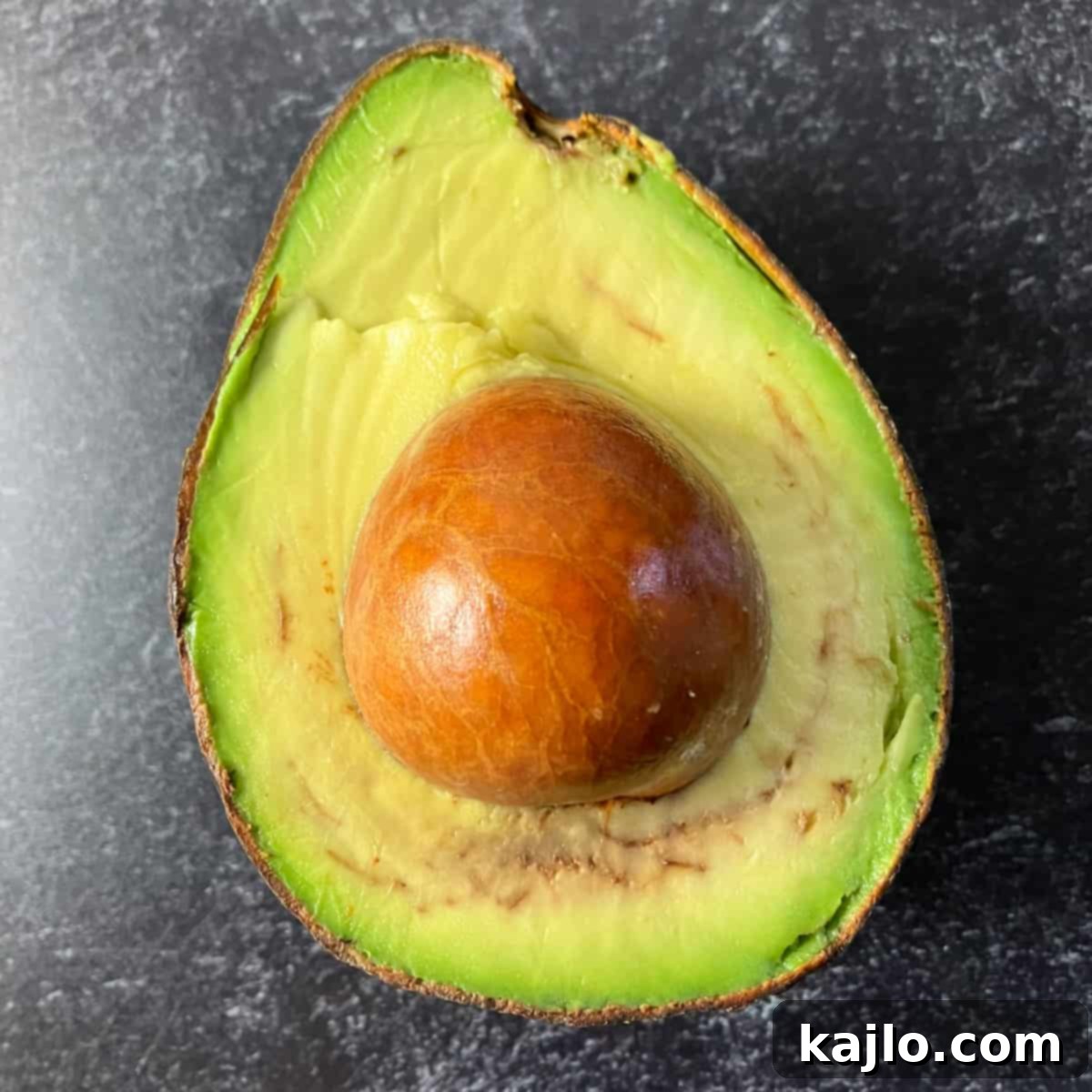
The browning is due to the oxidation of phenolic compounds within the vascular tissue, which are more susceptible to enzymatic reactions at lower temperatures or after cell damage. An avocado that has developed slight browning from refrigeration is still safe to eat. While the texture might be slightly altered, the nutritional value remains largely intact. Later in this guide, we’ll share practical tips on how to prevent avocado browning and creative ways to utilize avocados that have succumbed to cold-induced discoloration.
Avocado from Young Trees: A Natural Anomaly
A less common, yet natural, cause for internal discoloration is related to the age of the avocado tree itself. Sometimes, fruit harvested from young avocado trees may exhibit internal brown or black streaks. This is a physiological characteristic of early-stage tree production and is not indicative of spoilage or poor quality. These fibrous streaks might not be aesthetically pleasing and can sometimes affect the creaminess of the texture, but they are generally harmless for consumption. If you encounter these, know that they are a natural part of the fruit’s development from younger plants and do not pose a health risk.
Avocado Flesh Exposed to Oxygen: The Science of Oxidation
One of the most common reasons for encountering black spots in avocado, particularly after it has been cut, is exposure to oxygen. If you regularly consume avocados, you’ve likely noticed how quickly the vibrant green flesh begins to turn brown or black once exposed to air. This process, known as oxidation, occurs when enzymes within the avocado react with oxygen from the air, leading to the formation of melanin, which causes the discoloration.
Although visually unappealing, these oxidized black spots inside avocado are completely harmless. The avocado is still safe to eat, though the flavor might be slightly diminished in the oxidized areas. To minimize this problem, it is always best to use sliced avocado immediately after cutting. We will delve deeper into effective strategies for preventing oxidation and preserving the fresh green color of your cut avocados later in this article.
Spoiled Avocado: When Discoloration Signals Danger
While the previously mentioned reasons for brown or black avocado spots are generally safe, there is a critical distinction: genuine spoilage. If your avocado has truly turned spoiled or rancid, it should absolutely be thrown out without hesitation. Understanding the clear indicators of a spoiled avocado is paramount for ensuring food safety and protecting your health. Discerning between harmless browning and actual spoilage is the most important skill for any avocado enthusiast.
🛑 When Should You Not Eat an Avocado? Recognizing True Spoilage
Knowing when an avocado is genuinely unsafe to eat is crucial for food safety. You should never consume spoiled or rancid avocado, as it can lead to foodborne illness. While minor browning is often benign, certain signs clearly indicate that an avocado has gone bad and must be discarded. Here are the definitive indicators that your avocado should be thrown out:
- Off Smell: A fresh avocado has a subtle, pleasant aroma. If you detect a sour, chemical, or distinctly unpleasant odor, it’s a strong sign that the healthy fats in the avocado have turned rancid. This rancidity often precedes visible mold.
- Off Flavor: While it’s best not to taste an avocado if you notice other spoilage signs first, an avocado that tastes overly bitter, sour, or simply “off” is rancid and unsafe. This is another clear indicator that the fruit’s quality has deteriorated significantly.
- Visible Mold: Any fuzzy, white, black, or grey patches of mold, particularly near the stem-end or on damaged areas of the fruit, are an immediate red flag. Unlike hard cheeses, mold on soft fruits like avocados cannot simply be cut off, as its roots can penetrate deeply, and mycotoxins may be present throughout the fruit.
- Slimy or Overly Mushy Fruits: A ripe avocado should be creamy and yield gently to pressure. If the flesh feels slimy, overly soft, watery, or stringy beyond normal ripeness, it has likely begun to rot. This indicates significant bacterial growth and tissue breakdown.
- Withered Skin: While Hass avocados darken as they ripen, truly withered, shriveled, or extensively pitted skin that feels loose from the flesh can indicate severe dehydration and spoilage, especially if accompanied by other signs.
- Large Dark Streaks and Extremely Fibrous, Stringy Texture: While some vascular browning (brown lines) is safe, if the entire flesh is dominated by large, intensely dark streaks, especially when coupled with an excessively fibrous or stringy texture throughout the fruit and any of the other indicators on this list, it strongly suggests spoilage or extreme overripeness that has made the fruit unpalatable and potentially unsafe.
Can You Eat Avocado with Black Spots? Differentiating Safe vs. Unsafe
To reiterate and clarify: you can generally eat avocado with black spots inside if these spots were caused by common and harmless factors such as bruising, exposure to cold temperatures (vascular browning), or simple oxidation from air exposure. These types of black spots, though sometimes unappealing, do not pose a health risk. However, you should promptly throw out the fruit if the black spots on the avocado are extensive, soft, accompanied by mold, or are part of a broader pattern of spoilage (refer to the comprehensive indicators in the previous section). If the black spots appear throughout the entire flesh and are associated with a foul odor or slimy texture, discard the fruit immediately.
Can You Eat Avocado with Brown Spots on Skin? External Appearance vs. Internal Health
When assessing an avocado’s health, it’s important to consider both its external and internal appearance. Most avocados commonly found in US stores are Hass avocados, which are known for their distinct ripening process. These avocados typically start with a bright green skin that gradually darkens, often turning black or very deep purple as they ripen. During this transition, it is perfectly normal to see them develop brown spots on the avocado skin. These external brown spots are often just a natural part of the ripening process or minor cosmetic imperfections that do not affect the internal quality.
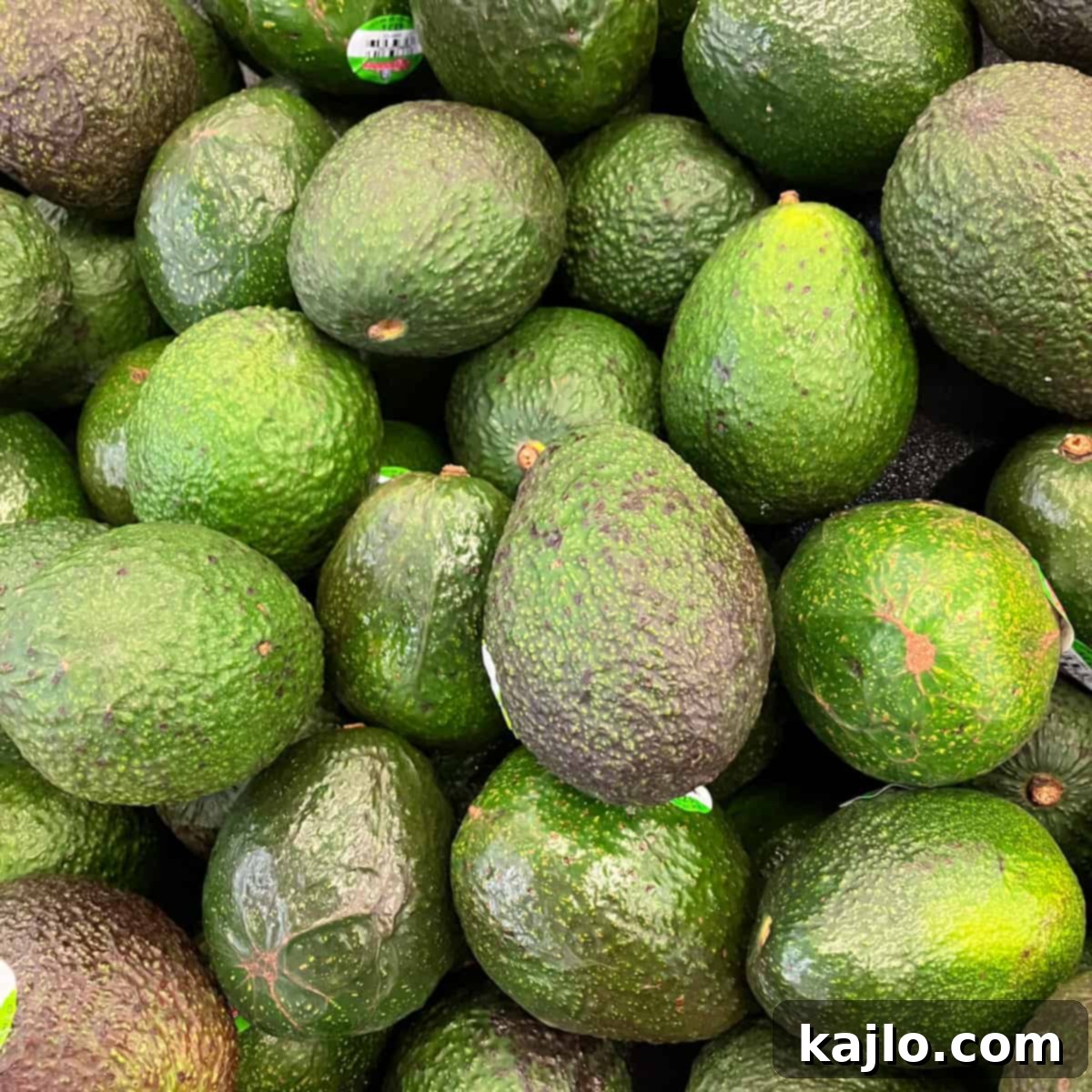
It’s also worth noting that not all avocado varieties follow the Hass ripening pattern. Some types of avocados, such as the Fuerte or Bacon varieties, maintain their green skin color throughout the ripening process, while others might turn more of a brownish-green. Therefore, blackened skin or an avocado with brown spots outside does not inherently indicate that the fruit has gone bad, especially for Hass avocados. The outward appearance of a ripe avocado can vary significantly between different types. However, regardless of the skin color, in nearly all cases, an avocado that is perfectly ready to eat will reveal a consistent medium to light green flesh when cut open, indicating peak freshness and optimal flavor.
🔪 Brown Spots on Avocado After Cutting: Understanding Oxidation
The rapid appearance of brown spots on avocado fairly quickly after cutting is a highly common observation, almost universally experienced by anyone who enjoys this fruit. This phenomenon is primarily due to enzymatic browning, or oxidation, as the avocado’s flesh comes into contact with ambient oxygen. While these brown spots undeniably alter the appearance of the avocado and might slightly impact its fresh flavor, they are universally recognized as safe to eat. The nutritional integrity remains largely intact, and there’s no health risk associated with consuming oxidized avocado flesh. The most effective way to keep cut avocados green and preserve their vibrant appearance is to diligently protect their exposed surfaces from oxygen.
🤔 Can You Get Sick From Eating a Bad Avocado? Risks of Spoiled Fruit
What happens if you eat a spoiled avocado? Just like with any other food that has gone bad, consuming a spoiled avocado can indeed make you sick. The consequences can range from mild discomfort to more severe food poisoning symptoms, depending on the extent of spoilage and the types of bacteria or molds present. You might experience an upset stomach, nausea, vomiting, diarrhea, and other unpleasant gastrointestinal symptoms. These symptoms are your body’s way of reacting to harmful microorganisms or toxins produced by spoilage.
Can You Eat Rotten Avocado? The Definitive No
Now that you have a clear understanding of “is brown avocado bad” in different contexts, the definitive answer regarding rotten avocados is a resounding NO. Please, under no circumstances, eat avocado that has genuinely spoiled or rotted. As mentioned, consuming rotten avocado carries a significant risk of food-borne illness, which can be particularly dangerous for certain individuals. It is especially important for those who are immunocompromised, elderly, pregnant, or very young children to strictly adhere to basic food safety rules and avoid eating any food that exhibits clear signs of spoilage. When in doubt, it is always safer to discard the avocado.
💡 What Can I Do with Brown Avocado? Creative Uses for Imperfect Fruit
Don’t despair if your avocado has developed some brown spots! While it might not be suitable for a pristine avocado toast, a slightly browned avocado is still perfectly usable for many delicious recipes where its color won’t be a focal point. One of my favorite recipes for brown avocado is a rich and creamy Avocado Smoothie for Weight Gain. In this recipe, the cocoa powder brilliantly hides any discoloration, allowing you to enjoy the avocado’s creamy texture and nutritional benefits without aesthetic concerns. Aside from smoothies, here are other fantastic ideas for using slightly browned avocado:
- Chocolate avocado pudding: The rich cocoa effectively masks the brown hue, creating a decadent, healthy dessert.
- Add to baked goods for moisture: Incorporate into quick breads, brownies, or muffins. The avocado’s healthy fats and moisture content can enhance the texture and richness, and its color will blend in seamlessly.
- Make a creamy salad dressing: Blend with herbs, lemon juice, and olive oil for a vibrant, healthy dressing that embraces the avocado’s texture.
- Use it in spreads: Perfect for a sandwich spread, dip, or even a base for a flavorful green sauce where the color isn’t paramount.
- Add to scrambled eggs or omelets: Mash it into your morning eggs for extra creaminess and nutrition, especially if the texture is still good.
⭐ How to Stop Avocado from Browning: Prevention is Key
Preventing avocado browning, particularly after cutting, is a common goal for many home cooks. The most straightforward and effective way to stop avocado from browning is to use it immediately after cutting. If you find yourself with more avocado than you can consume in one sitting, freezing any leftover avocado is an excellent long-term storage solution.
For shorter-term storage, such as keeping a cut avocado half in the fridge, the key is to protect the cut surfaces from exposure to oxygen. One highly effective method involves firmly pressing plastic wrap directly onto the cut surface of the avocado, ensuring there are no air bubbles, before placing it in the refrigerator. This creates a physical barrier that minimizes oxygen contact.
Other popular techniques to try include brushing the cut surface with a thin layer of a little olive oil or a squeeze of lemon or lime juice. The oil creates a physical barrier against oxygen, while the acidity in citrus juice contains ascorbic acid (Vitamin C), which is a powerful antioxidant that slows down the enzymatic browning process.
Another crucial step you can take to help prevent overall avocado brown spots, both internally and after cutting, is to pay careful attention to storage conditions before and after ripening. Avocados often have a very short window of opportunity when they are perfectly ripe. If your avocados tend to ripen and brown too quickly, avoid storing them next to fruits that produce ethylene gas, such as bananas, apples, or tomatoes. Ethylene is a natural plant hormone that accelerates ripening, and consequently, browning. Store unripe avocados at room temperature until they reach desired ripeness, then transfer them to the refrigerator to slow down further ripening and browning.
🌡️ How Long Does Avocado Last in the Fridge? Optimal Storage Times
Proper storage is vital for extending the life of your avocados and preventing premature browning or spoilage. According to FoodSafety.gov, whole, ripe avocados can be kept in the pantry until they reach peak ripeness, and then transferred to the refrigerator for up to 3-4 days to extend their shelf life. However, based on practical experience and the desire for optimal taste and texture, even with the tips to stop avocado browning mentioned above, a cut avocado is generally best consumed or refrigerated for no more than 1-2 days to maintain its best quality. Beyond this, the risk of texture degradation and potential spoilage increases.
🥶 Can You Freeze Avocado? Long-Term Preservation
While FoodSafety.gov advises against freezing fresh, whole avocados due to changes in texture upon thawing, the reality is that frozen avocado is widely available in stores and can be an excellent option for long-term storage of excess fruit. To successfully freeze avocados at home, it’s best to prepare them first. You can chop an avocado into cubes or mash it. To help prevent browning during thawing, sprinkle the cut or mashed avocado with a little lemon or lime juice. Then, store the prepared avocado in an airtight freezer bag or container, pressing out as much air as possible before sealing and placing it in the freezer. Frozen avocado is ideal for smoothies, dips, and baked goods, where a slightly softer texture after thawing is not an issue.
FAQs: Your Avocado Questions Answered
Is it OK to eat an avocado that isn’t ripe?
Yes, it is generally safe to eat an avocado that isn’t fully ripe, but it’s not typically recommended for the best culinary experience. Unripe avocados are safe to consume, but they will be firm, difficult to peel, and lack that characteristic creamy, buttery texture and rich flavor that makes avocados so appealing. Instead, they might have a somewhat starchy or bland taste. For the most enjoyable eating experience, allow avocados to ripen at room temperature. A perfectly ripe avocado will be green or golden under the stem cap and will yield to gentle pressure when squeezed lightly.
Why shouldn’t you eat a whole avocado?
The recommendation against eating a whole avocado in one sitting often stems from its calorie density. While avocados are incredibly nutritious, providing essential healthy fats, fiber, folate, vitamin K, and other vital nutrients, they are also a high-calorie fruit. A single medium-sized avocado can contain anywhere from 240 to 325 calories. For those managing their weight or calorie intake, consuming an entire avocado can quickly add a significant amount of energy to a meal. Typically, one-third of an avocado is considered a standard serving size. While avocados are packed with health benefits and can be part of a balanced diet, they are an energy-dense food that can contribute to weight gain if consumed in excessively large portions, especially if you have a weight loss goal. Enjoy them in moderation to reap their benefits without overconsuming calories.
Why do avocados not ripen in the fridge?
Avocados do not ripen effectively in the refrigerator because low temperatures significantly slow down the metabolic processes responsible for ripening. Ripening is a process driven by enzymatic activity and the production of ethylene gas, both of which are inhibited by cold. In fact, placing an unripe avocado in the fridge may halt the ripening process indefinitely, preventing it from ever reaching that perfect creamy texture. For the best eating experience, always allow unripe avocados to ripen on the kitchen counter at room temperature. Once they have reached your desired level of ripeness, you can then transfer them to the refrigerator to slow down further ripening and help prevent them from becoming overripe too quickly.
Why would an avocado have brown spots on leaves?
For the average consumer in the US, avocados are typically purchased without their leaves. This question is more pertinent to avocado growers or those with avocado trees. If you are an avocado grower and observe brown dots or spots on the leaves of your avocado trees, it can often indicate the presence of anthracnose. This is a common fungal disease that affects many fruit trees, including avocados. If left untreated, anthracnose can severely impact the health of your plants, potentially leading to significant defoliation, fruit rot, and even the death of the tree. Proper identification and treatment are crucial for the longevity and productivity of avocado groves.
Why does guacamole turn brown?
Guacamole turns brown for the exact same reason that a cut avocado browns: oxidation. The mashed avocado in guacamole, with its increased surface area exposed to air, is particularly susceptible to this enzymatic browning process. Typically, only the top layer of the guacamole, which is in direct contact with oxygen, will turn brown, while the rest underneath often remains vibrant green. You can significantly help prevent this unsightly browning by carefully pressing plastic wrap directly onto the surface of the guacamole, creating an airtight seal before storing it in the fridge. Additionally, incorporating lime or lemon juice into your guacamole recipe not only enhances flavor but also acts as an antioxidant to slow down the browning. For convenience, single-serve guacamole cups are a great way to enjoy small portions at a time without worrying about larger batches browning.
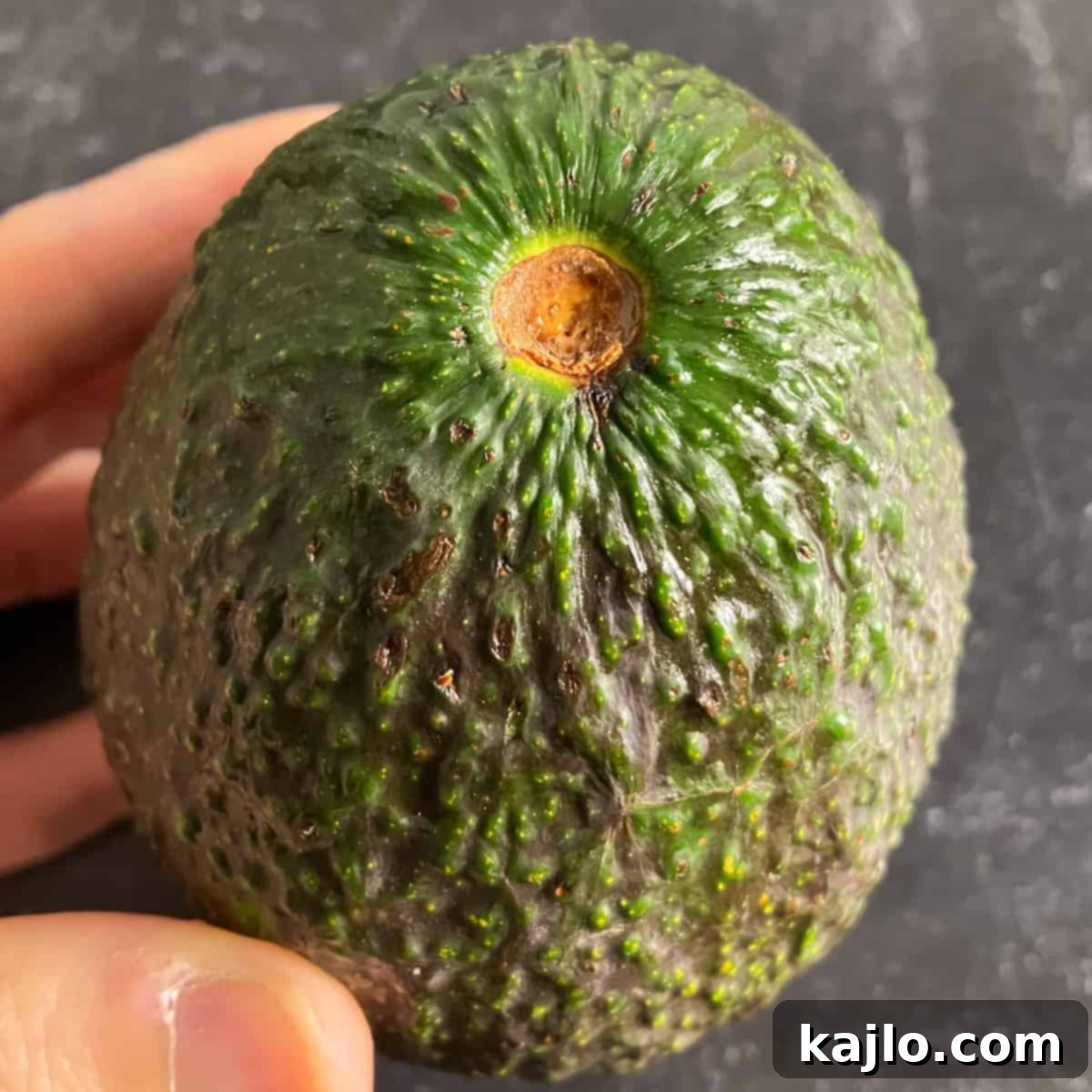
👨🍳 Delicious Avocado Recipes: Make the Most of Your Fruit
To help you enjoy avocados at their peak freshness and prevent them from developing unwanted brown spots, here are a few delectable recipes that will put your perfect, green avocados to good use:
- Peruvian Beans: A hearty and flavorful dish often elevated with fresh avocado.
- Smoked Salmon Sushi Bowl: Deconstructed and easy to make, featuring creamy avocado as a key ingredient.
- Vegetable Oats: A unique savory twist on oatmeal, made even better with sliced avocado.
- Pulled Pork Bowls: A satisfying meal where avocado adds a refreshing, creamy counterpoint.
- Air Fryer Toast (for perfect avocado toast, of course): The quintessential way to enjoy fresh avocado.
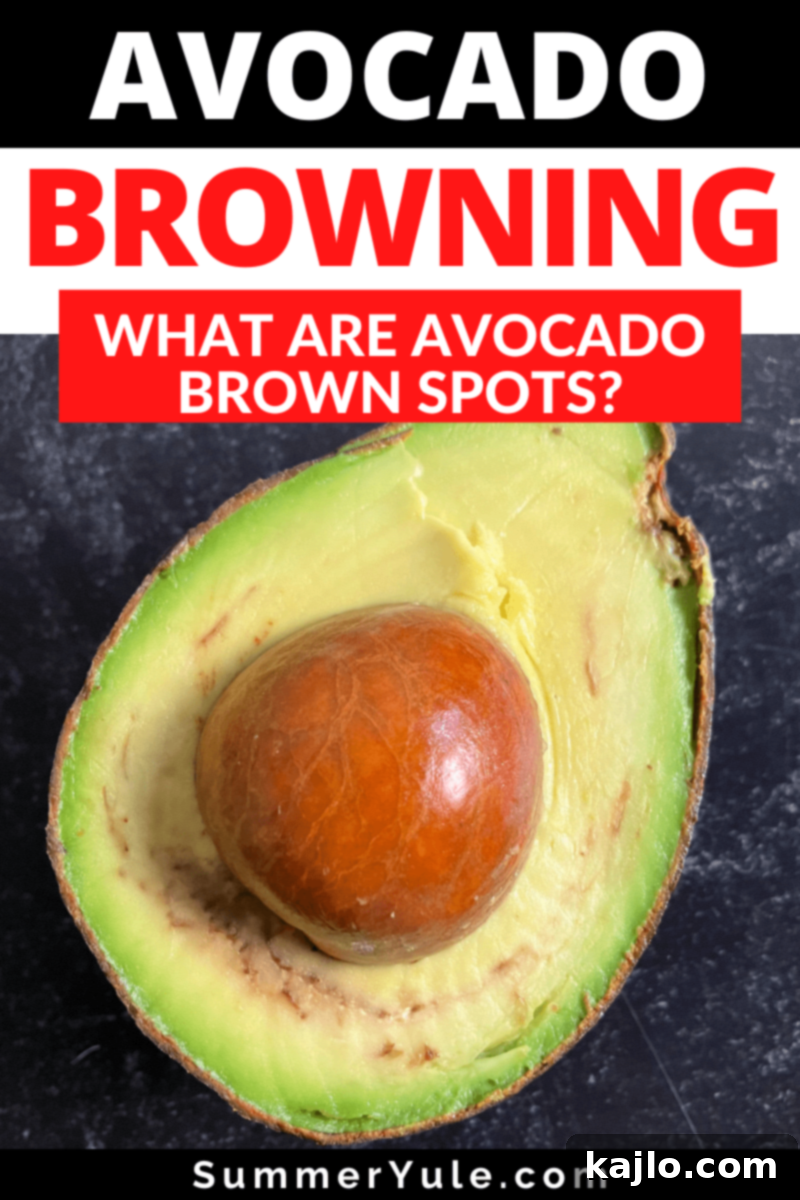
Join our vibrant community of healthy eaters! Subscribe to receive all the latest and greatest recipes, insightful health tips, and exclusive content directly to your inbox. Stay connected and follow me on Facebook, Pinterest, Instagram, and YouTube for daily inspiration and culinary adventures!
